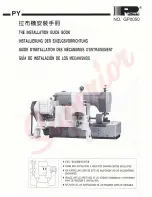
Tips & tricks
Help
207
Manual • Sewing machine W6 N 2000 Exklusive W6 N 2000 Exklusive • 27/04/2018 • 1.0 • GBR
An ill-fitting or damaged needle leads to skipped stitches and damages your
needle plate and hook race.
Does your machine skip stitches in the fabric? We recommend:
•
Use Super-Stretch Size 90 needles by W6 WERTARBEIT for stretch
fabrics or woven fabrics.
•
Use self-adhesive stabiliser to hold in place fabrics that tend to crimp.
•
Always use Super-Stretch 90 needles to sew jersey fabrics with a
synthetic fibre content. Nowadays over 95% of all jersey fabrics
contain synthetic fibres. Jersey needles are not suited for these fabrics.
14.2.4
Checking the needle plate
The sewing machine must be cleaned of lint and sewing dust regularly. It is
also important to clean the space below the needle plate in order for the
machine to transport the fabric smoothly and for the thread to run smoothly.
Remove the needle plate by using the small flat metal screwdriver (acces-
sory). Check whether the needle plate shows needle strikes or other
damage. If necessary, smooth these marks with fine emery paper. In the
event of excessive damage, the needle plate must be replaced, see „Main-
tenance“ > „Removing the needle plate“ (Page 199). You may order a new
needle plate online. Please access our website using the following link:
www.w6-wertarbeit.eu. After that, select “Spare Parts”.
If your needle plate is damaged, the fabric can no longer be transported
correctly. If there are impact points or other problematic areas, the thread
can no longer run smoothly.
The following illustration shows an example of a severely damaged needle
plate that must in any event be exchanged.
Severely damaged needle plate














































